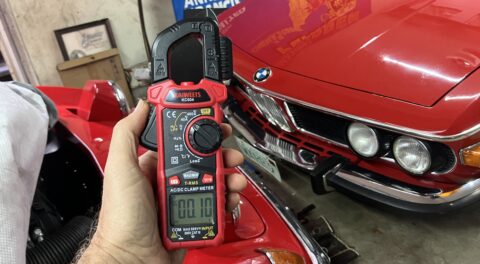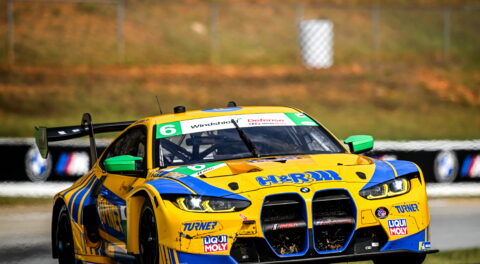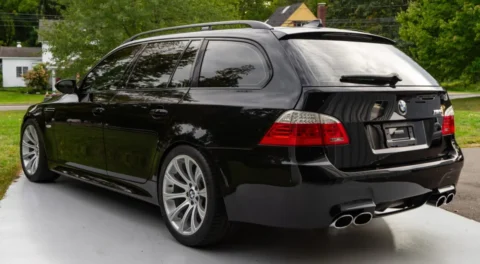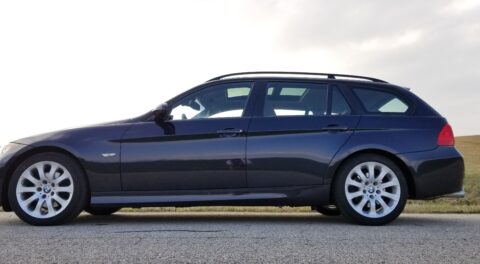Nearly a month after I submitted the Bavaria to Bring a Trailer, stopped short of paying the listing fee because two friends of mine (Jim and Susan) in Alabama who had bought two other cars from me (a short-duration E28 and “Kugel,” my long-time 2002tii) became interested in the car, we negotiated a price that included my readying the car for them to fly up and drive it home, and I went down several rabbit holes that were deeper than I expected, the car finally seemed ready for them to fly up this past Wednesday. I took one final test-drive on a 92-degree humid-as-soup day to stress-test the car on an errand-run to pick up starting fluid, windshield washer fluid, and a can of Fix-o-Flat to put in the trunk.
The car’s Freon-charged a/c did well, though it seemed to be dialed back a notch from what I remembered as its “so cold it hurts” performance. More importantly, it behaved well in the heat and humidity that has become more common in Boston over the decades, and will certainly be prevalent in the summer climate that the car will call home.
Until I got caught in traffic for five minutes. To my surprise and dismay, the temperature crept up over the middle of the gauge and tickled the 2/3 mark. I shut off the a/c and rolled down the windows, but it kept climbing. While it wasn’t yet in the red (more like 3/4 of the way up), it was certainly past my comfort zone. As we Bostoners say, I “banged a U-ie” to escape the traffic and get air flowing through the radiator. As soon as I was in motion, the temperature gauge settled back down.
When I bought the car eleven years ago, it had hot-running issues, all of which were solved by installing the lightly-used triple-core radiator. Having just replaced the water pump, fan, and all belts (I left the original fan clutch in place as it was working fine and I’m suspicious of the quality of new parts like this), the idea that it suddenly was working worse was somewhere between alarming and horrifying. I jacked the nose of the car up and re-bled the cooling system, but there was no air pocket.
I sent Jim and Susan a lengthy text describing the situation, then spoke at some length with Jim. I described what had happened, gave my measured take that nothing’s probably “wrong” other than the car is showing us what the limits of its cooling system are, then said that if their reaction was to postpone the pickup until cooler September weather prevailed, that would be understandable. But instead, Jim said about the most reassuring thing he could possibly have fired at me:
“Kugel does that.”
We agreed to stick with the plan for a Wednesday pickup.
Then, something occurred to me. I said to Jim that there’s a way to fool the a/c system to run the condenser fan without the a/c turned on, essentially turning it into an auxiliary cooling fan for the radiator. You turn on the a/c, then turn the temperature control all the way down. This shuts off the compressor but leaves the condenser fan on. At least that was my memory on how it worked on several of my cars. Of course, I’ve retrofitted the a/c myself into several of my cars, so maybe I just wired it that way. I made a note to show Jim how to do this as part of the handoff of the car.
On Wednesday, in preparation for their 4pm flight arrival, I organized all the spares as well as the contents of the hail of Amazon packages that Jim had sent to my house, and packed them space-efficiently in the trunk. When I was done, I thought “I should test this fan-only a/c mode to make sure it works.”
It didn’t.
And not only was the condenser fan not turning on with the temperature knob all the way down, it wasn’t turning on at all.
I began to trouble-shoot the problem, had just found that voltage was being sent to the relay that turns on the fan, and had wires disconnected and hanging, when my phone dinged. It was a text from Jim and Susan telling me that their plane had just landed.
Oh dear.
I picked them up in my E39 to avoid any risk to the Bavaria, and explained the just-discovered fan-not-turning-on situation to them. Jim said “Could the a/c condenser fan not being on have contributed to the car running hot?”
I actually hadn’t thought of that, but yeah, it was possible—having that hot a/c condenser core inches away from the radiator without the fan blowing heat from it certainly could have made things run hotter while the car wasn’t moving. It certainly would’ve affected a/c performance.
The plan was for them to come back to the house, drive the car, make the buy / no-buy decision (which was only a decision in my mind; they’d already decided to buy it), have the four of us go out to dinner, then to give them my E39 so they could head back to their hotel while I did one last laying-on of hands on the Bavaria and got the condenser fan working.
And that’s what happened. We first took the Bavaria on local roads, then up onto post-rush-hour traffic-free I-95. I had to prod Jim to get on the go pedal, but once he mashed it a few times, he found the addictive reservoir of torque and the rush from the Webers’ second barrel opening up. Jim’s a very laid-back guy, but once he was in the zone, a broad grin broke over his face, and he simply said “This is niiiice.”
After a lovely dinner at a nearby pub with Maire Anne, me, Jim, and Susan, everyone left me alone to finish what I’d started. I first wired the fan directly to the battery to make sure it worked. It did. It’s a Spal fan I installed when I rebuilt the car’s a/c eleven years ago. I’ve never had one die. That meant the problem was in the relay or the wiring. The wiring all checked out. I pulled out my box of BMW electrical doo-dads accumulated over the decades, dug out a few relays, and found one that was four-prong single-pole single-throw (SPST). Unfortunately, the DIN numbers for the prongs were no longer readable. However, in this piece I wrote, I tell you how to figure out which relay terminals are which. It’s nothing more than trial and error where you find the two prongs that, when fed 12V and ground, make the relay click. Those are on the low-current switched site of the relay (DIN numbers 86 and 85). The two remaining pins are on the high-current side of the relay (DIN numbers 87 and 30). When used to turn on something primitive like a fan, in my opinion it doesn’t matter if either of the pairs of terminals are interchanged as long as the relay has no diodes in it.
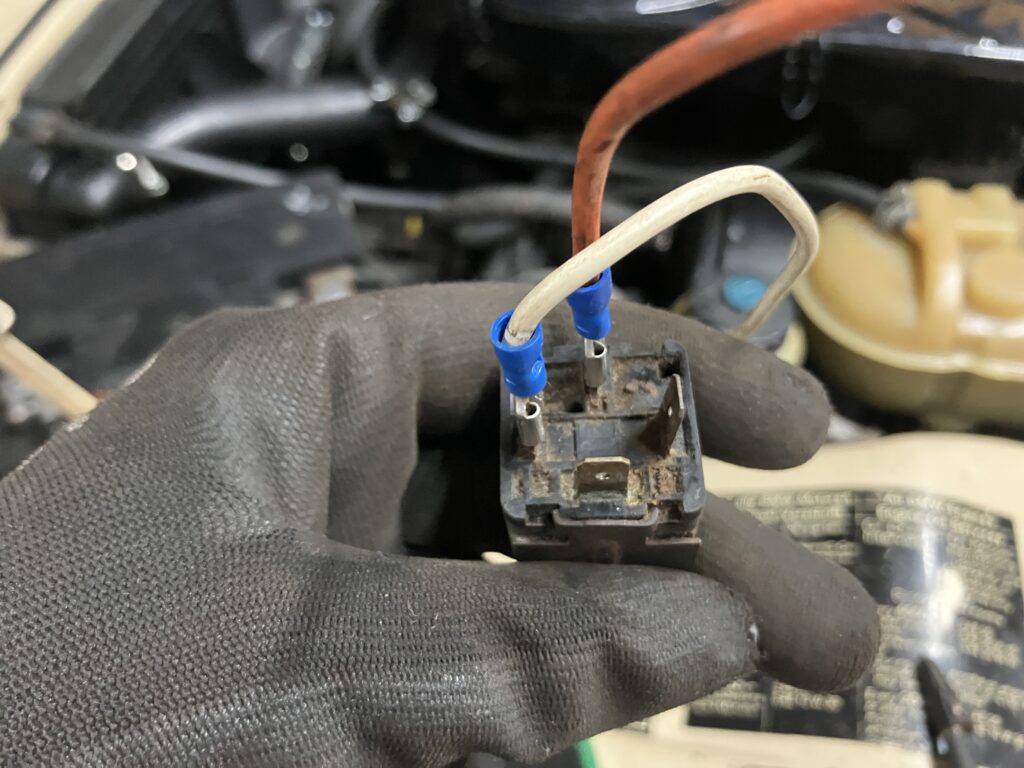
Finding relay terminals 86 and 85 through trial and error.
With the pinout determined, I connected the wires, made sure the fan turned on, then mounted the relay on the inner fender. As pictured:
- 85 is low-current 12V turn-on from a/c blower fan switch
- 86 is ground
- 87 is fused always-on voltage from the battery
- 30 is high-current voltage output to the fan motor, the negative leg of which is grounded
As per above, in normal DIN numbering, each pair of these is usually swapped from this order, but it really doesn’t matter, this was the order in which I tested them and got it working, so that was what I ran with.
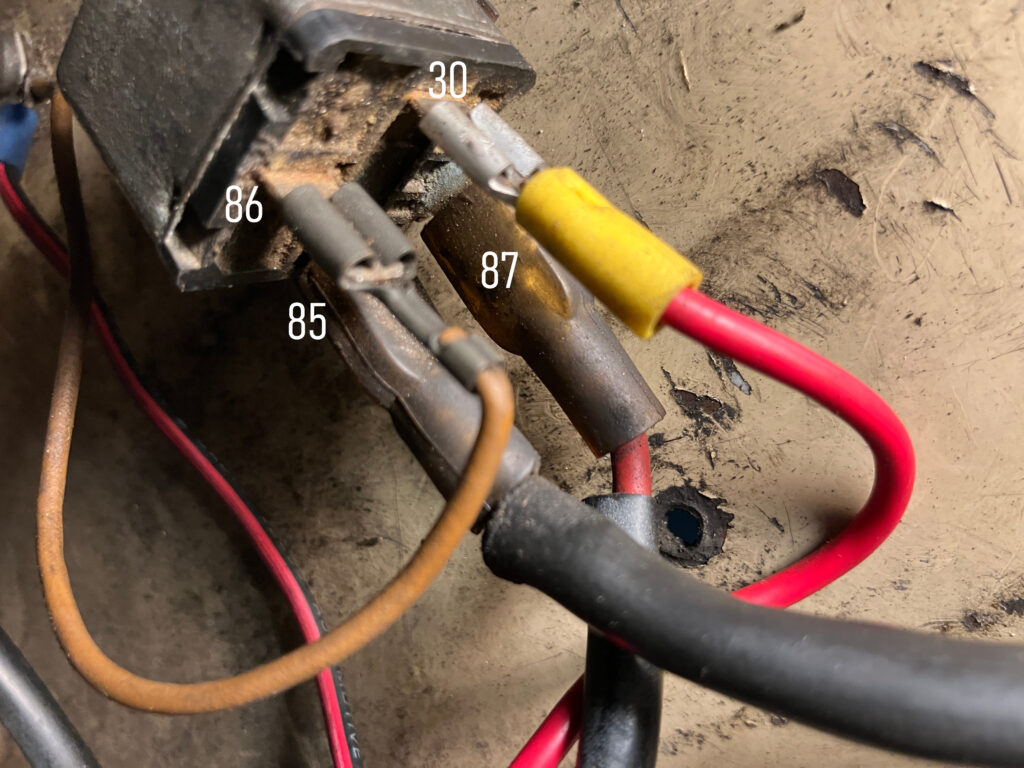
Done.
I thought I was done until I remembered the whole thing about the special fan-only a/c mode. I twisted the a/c temperature knob all the way to the left, and turned on the a/c blower switch.
Both the compressor and the condenser fan turned on. There was nothing I could do to make only the fan turned on.
Hmmmmn.
I looked at the wiring, and saw that the condenser fan wire was just an extension of the compressor wire. While this wasn’t how it was wired on some of my other cars, this probably was how it was originally wired on the Bavaria. Unfortunately, it meant that there was no easy way to make the condenser fan turn on by itself. I made a note to show Jim how, if it was an emergency, to unplug the compressor wire, as that would make the fan run alone.
The following morning, before I drove the Bavaria to the nearby hotel where Susan and Jim were staying, it was raining. That made me think about the Rain-X windshield wiper fluid I’d put in the trunk, and that I should use it to fill the reservoir. As I was about to do that, I realized that I should test the windshield washer pump.
It didn’t work.
Birgit, you old girl, are you getting needy because you don’t want to leave?
I connected the washer’s wires to a voltmeter and verified that the pump was indeed receiving voltage, so the problem was the pump itself. I used to have a seemingly inexhaustible supply of windshield washer pumps, but the only other one I found didn’t work either. I pulled the pump off the reservoir, and used a tiny socket to remove the bolts holding the plate that connects the little pump itself to the electric motor that drives it. Often, one or both of these is stuck due to age and corrosion, and can easily be freed up with a little SiliKroil and rotation. Fortunately the problem was in the pump (shown below). A little squirt, a few twists with a needle-nosed Vise Grips, and the washer pump wheeeeeee’d back to life.
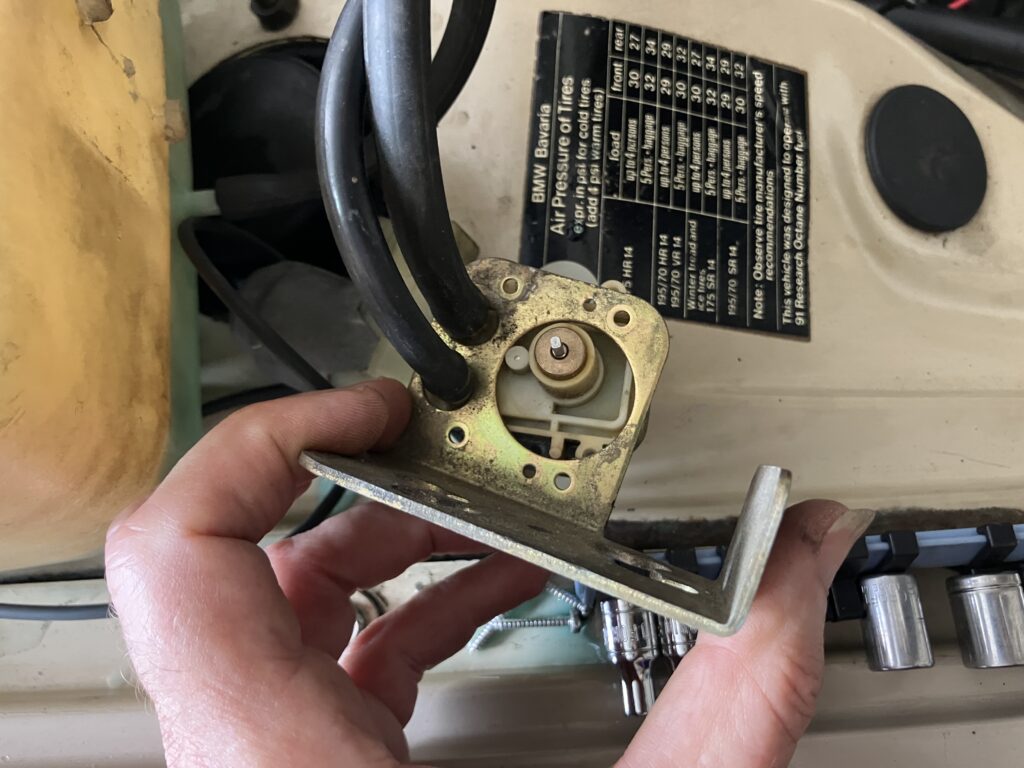
Lucky me.
And with that, I drove to the nearby hotel and passed papers with Jim and Susan. There was the issue of payment for the additional work I’d done, which we’d all put off resolving because we trusted each other completely. They wanted to pay me for my time. I said no, just parts. But I didn’t want them to pay me for parts I would’ve bought anyway if the car went up on BaT. They said no. You couldn’t have asked for a fairer more respectful discussion of remuneration for a car sold between friends.
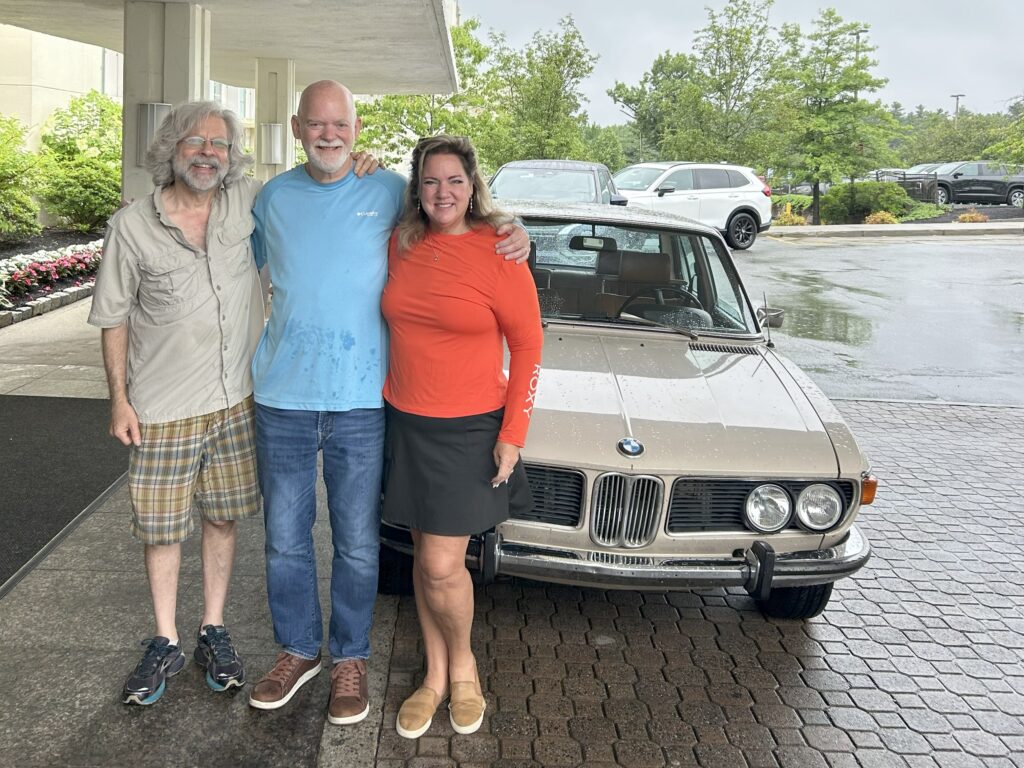
Happy seller and buyers.
My final farewell to the car was seeing it parked next to my E39 in the rain when I pulled my umbrella out of it.
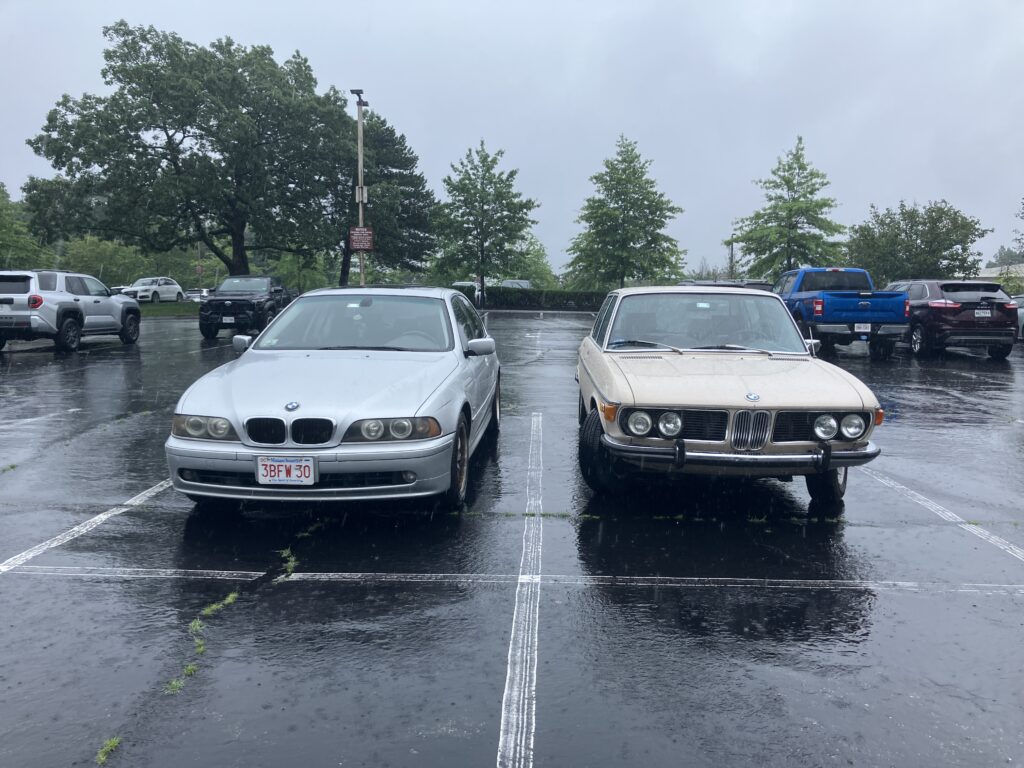
Sigh.
Whenever I sell a car I’ve had a long and positive experience with, it’s customary for me to quote Neil Young:
long may you run
long may you run
although these changes have come
with your chrome heart shining
in the sun
long may you run
In fact, when I’d sold Kugel to Jim and Susan five years ago, they’d brought along a guitar, and I played the song.
My friend Keith Martin (publisher of Sports Car Market magazine) is delightfully philosophical about letting go of cars. The anatomy of the relationship with a car is usually passion at the beginning, then necessary repairs and sort-out and mods, then road trips, then a natural cooling-off. If you own multiple enthusiast vehicles, the car goes into the stable with the others and gets used less and less. Even if you love a car, Keith says, there’s no shame in letting it go, because you’ll always have the memories, and the ones of that early period of ownership are always the best. That describes my time with the Bavaria to a tee. I was barely using it, I needed to let go of at least one of the 14 cars to keep the storage situation and the bank account happy, and selling the Bavaria made the most sense. I don’t think I’ll regret it. It was a wonderful car, I had a great time with it, and it’s going to the best possible owners.
But… yeah. Mögest du lange laufen.
—Rob Siegel
____________________________________
Rob’s latest book, The Best of The Hack Mechanic, is available here on Amazon, as are his seven other books, including Just Needs a Recharge: The Hack Mechanic Guide to Vintage Air Conditioning. Signed copies can be ordered directly from Rob here.
Tags: bavaria overheating wiper pump

